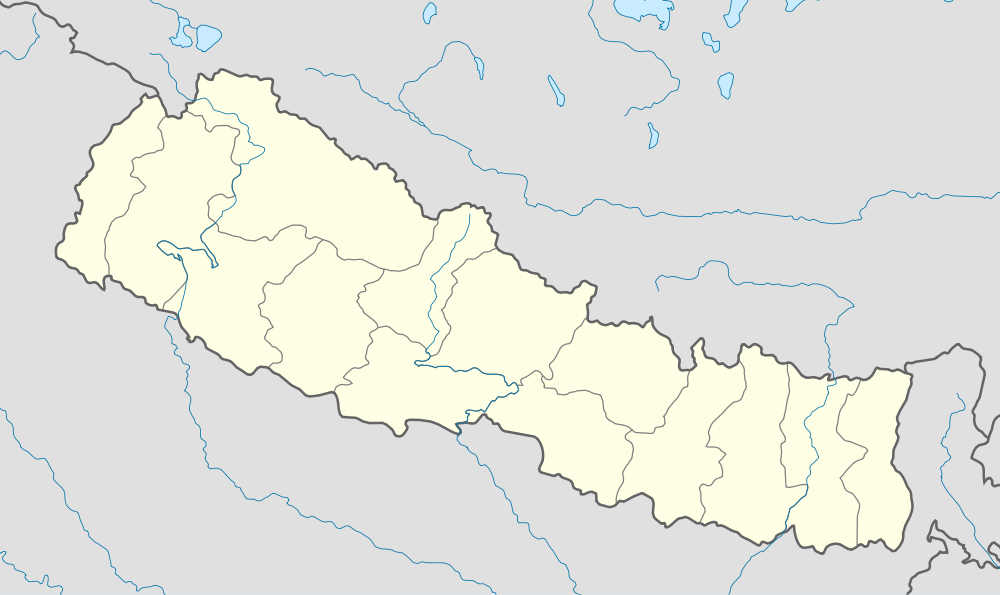Pipra (village)
Pipra (पिपरा) a village in Mahottari District, Janakpur Zone in the Central Region of Nepal.
According to the 2011 census, the population of the village is 9,373 persons, living in 1635 households.[1]
| Pipra पिपरा | |
|---|---|
| Village | |
 Pipra Pipra (Nepal) | |
| Coordinates: NP 26°40′52.8132″N 85°51′20.0016″E / 26.681337000°N 85.855556000°ECoordinates: NP 26°40′52.8132″N 85°51′20.0016″E / 26.681337000°N 85.855556000°E | |
| Country |
|
| Development Region | Central Development Region |
| Zone | Janakpur |
| District | Mahottari |
| Population (2011) | |
| • Total | 9,373[1] |
| Time zone | NST (UTC+5:45) |
| Area code | 044 |
Overview
Pipra lies about 8 km (5 miles) from Janakpur on the main highway linking it to Jaleswor, the district headquarters of Mahottari District. Its GPS coordinates are: 26° 40' 52.8132 North and 85° 51' 20.0016 East.[2]
Demographics
General
According to the Village Development Committee/Municipality data from the National Population and Housing Census 2011, Pipra had a total population of 9,373 living in 1,635 households. There are 4,787 males and 4,586 females in the village (Sex ration: 104.38 males per 100 females).[1]
Housing
1,624 of the 1,635 households owned the dwelling they resided in. Majority of the houses in the village (887) are of 'wooden-pillar' type, followed, respectively by: cement bonded brick/stone (580), mud bonded brick/stone (119); and 23 houses are reinforced concrete structures.[1]
85% of the households are supplied by water by tube-wells or hand-pumps (1,390) and 11.5% have tap/piped water (189). 0.2% households derived their water from wells (covered or uncovered, 2 each) and 3% had 'other' sources (52).[1]
In terms of sanitation, more than 60% of the households (1,093) do not have toilets. However, of the households that do (526), 71.1% (374) have toilets with flushes installed.[1]
Electricity and Fuel
Pipra is considered generally electrified with good electrical coverage, 61.2% of the households are electrified and use electricity for lighting; 604 households use kerosene wick lamps; importantly, 10 of the 1635 households have solar lighting units installed.[1]
In terms of household fuel, 1,115 households rely on firewood, 343 on cow-dung-cakes (*guitha*), 121 on liquefied petroleum gas (LPG), 21 on kerosene, 9 on bio-gas installations and 26 on 'other' sources.[1]
Interestingly, with 43 households having fridges, the village has the highest number of households with refrigerators in the district, outside of the district headquarters, Jaleshwor (a municipality, considered a town).[1]
Media and Communication
513 households in the village have functional radio sets, 716 have working televisions (of which 171 have cable connection, normally through a satellite dish). 44 households have computers of which 6 are connected to the internet. 53 houses have fixed line telephones and 887 have at least one mobile phone.[1]
Transport
31 of the households have some form of a four-wheeler (including tractors), 173 have motorcycle (or other two wheeled engine driven vehicle) and 8 households having 'some other form of transport', generally implying ox drawn carts or three wheel power-tiller pulling a trailer.[1]
Education and Language
In terms of languages, 9,118 use Maithili as their mother tongue, 123 use Hindi, 89 Magahi, 24 Rai and 19 using 'other' languages.[1]
The village has an overall literacy rate of about 47%. Males have a higher literacy rate than females (56.24% as compared to 37.41%).[1]
Economy
The economy of the village is primarily agrarian with few shops and services located near the village centre.
Rastriya Banijya Bank used to maintain a branch in the village that offered lending services to farmers in Pipra and nearby villages. This branch was merged with the district head-office of the bank located in Jaleshwor, in 2002, during the Internal Armed Conflict in Nepal.[3]
The local economy of the village has been provided with a major boost by money remitted by migrant workers hailing from the village but now working overseas in the Gulf and Middle East and in South-East Asia. According to conservative estimates, nearly a third of the village's population, particularly those between 18-45 years of age, work in Saudi Arabia, Qatar or Malaysia. Furthermore, there are reports that young men, below the age of 18, some as young as 14, have also traveled for migrant work on forged documents.[4]
Climate
Pipra has all four seasons of the year.
March to August are generally considered as Summer with average temperature in the mid 30-degree Celsius. December and January are generally cold with extended periods of Seet-lahar a period of extended days where fog and low-clouds block the sun resulting in low highs. September-October and February are the Autumn and Spring months, respectively.
Education
Pipra has a government-run high school and a few privately run schools.
Law Enforcement
There is a small police office in the village comprising about 12 Nepal Police personnel under the command of a Assistant Sub-Inspector (ASI). Furthermore, a Quick Response Team (QRT), comprising 6 personnel in a interceptor vehicle (Tata 407 pickup truck) is permanently based in the village this team coordinates with village police office but takes orders from the District Police Office located in Jaleshwor, the district headquarters.
Notable People
- Bhadrakali Mishra, Politician, Minister (numerous portfolios) and Chairman of King Birendra's Royal Privy Council
- Dr. Pravin Mishra, Secretary, Ministry of Health and Population, Government of Nepal
- Ram Narayan Mishra, Minister
- Shyam Nandan Prasad Mishra, Minister of Foreign Affairs (India)
References
- 1 2 3 4 5 6 7 8 9 10 11 12 13 National Population and Housing Census 2011, Village Development Committee/Municipality Profiles : Mahottari (PDF). Central Bureau of Statistics, National Planning Commission Secretariat, Government of Nepal. March 2014. Retrieved 1 August 2016.
- ↑ Atlas of Nepal. Kathmandu, Nepal: Government of Nepal, Department of Maps. c. 2012.
- ↑ "Branches - Rastriya Banijya Bank". www.rbb.com.np. Rastriya Banijya Bank, Nepal Ltd.
- ↑ Yadav, Anumeha. "Why Nepal's poorest people are risking their livelihoods by blockading the border". Retrieved 1 August 2016.